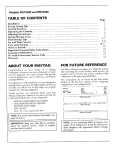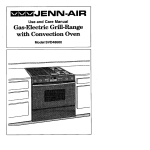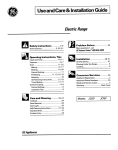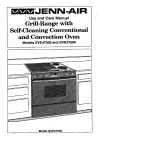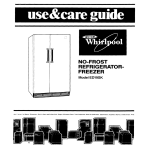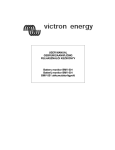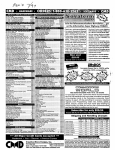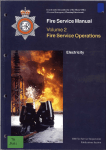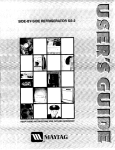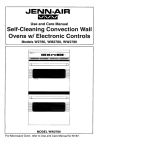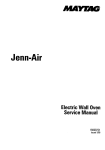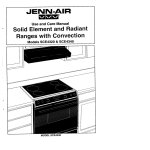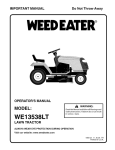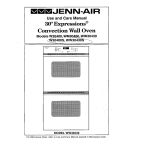Download Jenn-Air W2720 User's Manual
Transcript
JENN-AIR
Use and Care Manual
Self
Cleaning Wall Owv_s
Mode_s W24'10/W2/450,,_V2_O,
)
WM;_7'20,WlVI_750,WW_460 & WW2750
MODEL W2750
For Microwave Oven, refer to Use and Care Manual for M167.
About
Your Jenn-Air
Congratulations
on your choice of a Jenn-Air waii oven. Your Jenn
convection oven combines the best of two cooking methods, convection
radiant bake (conventional) baking or roasting, in a se f-cleaning oven. (N
Only Models W2450, W2750, WM2750. WW2460 and WW2750 have
convection option.)
The Jenn-Air convection oven is actually a conventic:al oven that circuk
heated airwithin the oven. As both bake and broil heatir g elements cycle on
off with the thermostat, a fan keeps the heated air circuiating around the f(
The constantly recirculating heated air in the convecticn oven strips away
layer of cooler air that surrounds food. Consequently. many foods cook rr
quickly. Evenly distributed heat makes multiple rack coc<ing possible. Con\
tion roasted meats retain their natural flavor and juiciness with less shnnk
than radiant bake roasting.
In addition to the many exclusive benefits of cenvecticr_ cooking, your ove
also a fine full featured "bake and broil" oven.
You can cook your "old favorite" recipes as you have n the past. The radi
bake oven also gives you the flexibility of preparing various foods wi"
convection cooking may not be as beneficial, as when ccoking foods in cove
casseroles or clay pots.
The broil element is convenient for top browning and even broiling of food,,
The time bake feature can be used with either the convection or radiant b_
oven.
Before you begin cooking with your new oven, please take a few minutes to re
and become familiar with the instructions in this book. On the following pa(
you will find awealth of information regarding all aspects cf using your newov
By following the instructions carefully, you will be able to frilly enjoy and prop_
maintain your oven and achieve exce{lent resu{ts with the food you prepar{
Should you have any questions about using your Jenn-A;r oven, write to us.
sure to provide the model number.
Consumer Relations Department
Jenn-Air Company
3035 Shadeland Avenue
Indianapolis, IN 46226-Q901
2
Index
Baking
General Recommendations ..........................................
13
Convection Baking ..................................................
15-16
Baking Charts ..........................................................
14-15
Multiple Rack Cooking ..................................................
16
Broiling ..........................................................................
20-21
Cleaning
Auto-Clean ...................................................................
23
Self-Cleaning Process .............................................
22-27
Other Cleaning Tips ................................................
28-29
Clock Controlled Baking or Roasting ............................
10-11
Clock Controls ..................................................................
8-9
Control Panel ....................................................................
6-7
Light Bulb Replacement .....................................................
28
Minute Timer ................................................................................. 9
Oven Temperature Knob Adjustment ......................................... 29
Rack Positions ............................................................................ 12
Roasting
General Recommendations ...................................._............. 17
Radiant Baking Roasting ...................................................... 17
Convection Roasting ........................................................ 18-19
Safety Precautions .................................................................... 4-5
Service Information ................................................................ 30-31
3
SAFETY PRECAUTIONS
Read before operating your oven
All appliances - regardless of the manufacturer- have the poten
through improper or careless use to create safety probler
Therefore the following safety precautions should be observe,
1. Be sure your appliance is properly installed and grounded
a qualified technician.
2. Never use your appliance for warming or heating the roc
3. Children should not be left alone or unattended in area wh_
appliance is in use. They should never be allowed to sit
stand on any part of the appliance.
4. Wear proper apparel. Loose-fitting or hanging garme_
should never be worn while using the appliance.
5. Do not repair or replace any part of the appliance unl(
specifically recommended in this manual. All other servici
should be referred to an authorized Jenn-Air Service C_
tractor.
6. Flammable materials should not be stored in an oven.
7. Do not use water on grease fires. Smother fire or flame or L
dry chemical or foam-type extinguisher.
8. Use only dry potholders. Moist or damp potholders on I
surfaces may result in burns from steam. Do not let pothold
touch hot heating elements. Do not use a towel or other bul
cloth.
9. Use care when opening oven door. Let hot air or ste_
escape before removing or replacing food.
10. Do not heat unopened food containers. Build-up of pressu
may cause container to burst and result in injury.
11. Keep oven vent ducts unobstructed.
12. Always place oven racks in desired location while oven
cool. If rack must be moved while oven is hot, do not
potholder contact hot heating element in oven.
13.
14.
15.
16.
17.
18.
Do not clean door gasket. The door gasket is essential for a
good seal. Care should be taken not to rub, damage, or move
the gasket.
Do not use oven cleaners. No commercial oven cleaner or
oven liner protective coating of any kind should be used in or
around any part of the oven.
Clean only parts listed in this manual.
Before self-cleaning the oven, remove broiler pan and other
utensils.
Listen for fan. A fan noise should be heard during the broil
and cleaning cycles. If not, call a serviceman before selfcleaning again.
DO NOT TOUCH HEATING ELEMENTS OR INTERIOR
SURFACES OF OVEN. Heating elements may be hot even
though they are dark in color. Interior surfaces of any oven
become hot enough to cause burns. During and after use, do
not touch, or let clothing or other flammable materials contact
heating elements or interior surfaces of oven until they have
had sufficient time to cool. Other surfaces of the appliance
may become hot enough to cause burns-among these surfaces are: oven vent openings and surfaces near these
openings, oven doors, windows of oven doors.
IMPORTANT SAFETY NOTICE AND WARNING
The California Safe Drinking Water and Toxic Enforcement Act of
1986 (Proposition 65) requires the Governor of California to
publish a list of substances known to the State of California to
cause cancer or reproductive harm, and requires businesses to
warn customers of potential exposures to such substances. Users
of this appliance are hereby warned that when the oven is engaged
in the self-clean cycle, there may be some low level exposure to
some of the listed substances, including Carbon Monoxide. Exposure to these substances can be minimized by properly venting the
oven to the outdoors during the self-clean cycle.
Oven Operation
Oven
Control
Panels
Indicator lights:
Bake
Oven light switch
\
==,UI,=._.,
Selector
knob
_T_
`
\
,==_,..'
\
Door lock
lever
Clock controls
and minute timer
Single Wall Ovens
Lower oven
selector knob
\
Lower oven
Upper oven indicator
lights:
Upper oven
light switch
//Clean
light switch
Upper oven
selector knob
Door lock
lever
Upper oven
temperature knob
Double Wall Ovens
minute timer
Oven Light Switch
• For some models, the oven light automatically comes on whenever the oven door
is opened. The oven light may be turned on by pushing the control panel switch in.
Light cannot be turned on during the self-cleaning process.
Selector
Knob
• This knob controls the oven operation. To operate the oven, turn to desired setting
and turn TEMPERATURE knob to desired setting.
The settings
OFF
BAKE
'PIXIEBAKE
CONVECT
TIME CO_CT
BROIL
CLEAN
are:
The oven will not operate when knob is on this setting. Keep
knob on this position when oven is not in use.
Use for radiant bake (conventional) baking or roasting.
Use with clock controls for automatically starting and stopping
oven when baking or roasting in the radiant bake oven.
Use for convection baking or roasting. (Selected models only.)
Use with clock controls for automatically starting and stopping
oven when baking or roasting in the convection oven.
(Selected models only.)
Use for top browning or oven broiling of foods.
Use for self-cleaning process.
Temperature
Knob
• Use to set oven temperature. Be sure the indicator square is in line with the exact
temperature desired. This knob is used with all oven operation settings noted on the
SELECTOR knob.
Door Lock Lever (All models
except
W2410 & WW2460)
• Use to [ock oven for self-cleaning process.
Bake Indicator
Light
• Indicates when oven isturned to an operating position other than the CLEAN setting.
Light will glow until the desired temperature is reached. It will cycle on and off as this
temperature is maintained during cooking.
Lock Indicator
Light
• Will glow after the oven door has been locked and after the oven temperature is over
550OF. Doorwilllockautomaticallyandcannotbeopeneduntiloventemperature
drops below 550°F and the lock indicator light goes off.
Clean Indicator
Light
• Indicates when all controls have been properly set forthe self-cleaning process, Light
will remain on during the entire cleaning process.
Clock Controls
and Minute
Timer
• Features time of day, MINUTE TIMER, and clock controls to start and stop oven
automatically. (See pages 8-11)
Clock
Controls
INDICATOR
WORDS
DISPLAY WINDOW
/
/
12 HOUR
TIME OF DAY CLOCK
Clock
\,
Mh_UTE AND SECOND
TIMER
Setting
IMPORTANT: The clock is a 12 hour clock. When oven is first supplied power or power
is interrupted, the display will show "00:00".
To set time
of day
on clock:
1.
Turn SETdial counterclockwise untilthe word TIME appears in the DisplayWindow.
Then, turn the SET dial in either direction until the correct time appears in window.
2.
Push ENTER button.
To change
time
of day set on clock:
Repeat above sequence.
To check time of day when timer is in use: Push ENTER button. Time of
day will be displayed briefly, then display will return to timer function.
Minute
Timer
IMPORTANT: This interval timer can be used to remind you when a period, up to 99
minutes and 00 seconds, expires. Itcan be used independently of any other oven activity
and can be set while another oven function is operating. The timerdoes notcontrol the
oven.
To
1.
set
MINUTE
TIMER:
Turn SET dial clockwise
Display Window.
EXAMPLE:
until desired
number
of minutes and seconds
appear
in the
Turn the dial to 5 for 5 seconds or to 5:00 for 5 minutes.
DISPLAY
5 SECONDS
5 MINUTES
IMPORTANT:
This is the on/y function where time entered is in minutes and
seconds. Minutes are to the left of colon and seconds to right of colon.
2.
Push ENTER button.
The indicator word TIMER will remain in Display Window during countdown.
Countdown will have display precedence over anything else programmed, such as
TiME BAKE. At end of time set, the indicator word TIMER will blink and timer will
beep. Beeping will continue every f 0 seconds for 15 minutes unless the CANCEL
button is pushed once. After CANCEL button is pushed. Display will return to time
of day or whatever is programmed on control panel.
To cancel
MI_FI..YrE TIMER:
Push CANCEL button once.
button twice will cancel a//programming (time bake or serf-dean).
Pushing CANCEL
Clock-Controlled
Baking"
or Raastlna
•
o"
To set oven to start
immediately
and shut off automatically:
I. Turn SELECTOR knob to TIME BAKE or TIME CONVECT (SelectedModelsOnt_,
2. Turn TEMPERATURE knob to desired temperature.
3. Hold in STOP TIME button until the indicator words STOP TIME appear in Displ_
Window.
4. Turn SET dial to time you want food to stop cooking.
EXAMPLE: If time of day is one o'clock and the roast needs to cook for 3 hour
the stop time would be four o'clock.
i.n t-1
i.u u
TIME OF DAY
5.
DISPLAY
STOP TIME
Push ENTER button to enter stop time.
The indicator word AUTO will appear in the Display Window and oven will st
heating. The BAKE indicator light will glow until the desired temperature is reach_
When stop time is reached, the oven shuts off and the indicator word AUTO
begin to blink and timer will beep. Seeping will continue every 10 seconds for
minutes unless the CANCEL button is pushed twice.
To set oven to start
at future
time and shut off automatically:
1. Turn SELECTOR knob to TIME BAKE or TIME CONVECT (Selected Models
Only).
2, Turn TEMPERATURE knob to desired temperature.
3. Hold in START TIME button until the indicator words START TIME appear in
Display Window.
4. Turn SET dial to time you wish food to start cooking.
EXAMPLE: If time of day is _ 1:30 and the roast needs to start cooking at one
o'clock, turn dial until numbers 1:00 appear in display.
, l:3n
DISPLAY
I
TIME OF DAY
5.
6.
START TIME
Push ENTER button to enter start time.
The indicator words STOP TIME will appear in Display Window as a reminder
set STOP TIME.
Turn SET dial to time you want food to stop cooking.
EXAMPLE: If star( time is one o'clock and the roast needs to cook for 3 hour_
the stop time would be four o'clock.
DISPLAY
START TIME
7.
STOP TIME
Push ENTER button to enter stop time.
The indicator word AUTO will blink in the Display Window. When start tim,
reached, the indicator word AUTO will remain in Display Window. The S,a
indicator light will glow until the desired temperature is reached. When stop t
is reached, the oven shuts off and the indicator word AUTO will begin to blink
timer will beep. Beeping will continue every 10 seconds for 15 minutes unless
CANCEL button is pushed twice.
lO
To check STAt_T TL_IE be/bre cooking
begins: Hold in START TIME butt
until the words START TIME appear Jnthe Display Window. The star time wJ]l
displayed briefly, then Display will return to time of day.
To change
1.
2.
3.
ST._RT
TIM_E before
cooking
begins:
Hold in START TIME button until the words START TIME appear in the Disp]
Window.
Turn SET dial to desired time.
Push ENTER button twice to enter new start time and stop time previot
programmed.
To check
STOP TlIWIE: Hold in STOP TIME button until the words STOP TI
appear in the Display Window. The stop time will be displayed briefly, then Display
return to on-going program.
To change
1.
2.
3.
STOP
TItlE:
Hold in STOP TIME button until the words STOP T(ME appear in the DisF
Window.
Turn SET dial to desired time.
Push ENTER button to enter stop time.
To Cancel
function
programmed:
Push CANCEL button twice to car
function, during programmed time or after time has expired.
NOTE: After clock-controlled baking, turn SELECTOR and TEMPERATURE knoL
OFF position.
NOTE:
Since food continues to cook if/eft in the oven,it is suggested that the c
controls be used primarily to start the oven when no one is in the kitcl
Provisions should be made to have thefood removed as soon as the signal
sounded.
NOTE:
If more than 7 seconds elapses between holding in START TIME butto
or STOP TIME button and turning the SET dial, the display window wi
automatically return to on-going program.
NOTE:
If more than 1 minute elapses between turning SET dial to a new time an
entering new START TIME and STOP TIME, the entire program will t
cancelled and display will return to time of day clock.
11
Oven
Operation
Baking
or Roasting
1. Locate oven racks on proper rack positions.
2. Turn TEMPERATURE knob to desired temperature.
3. TurnSELECTORknobtoBAKEorCONVECTsetting.
WhentheBAKEINDICATO
UGHT cycles off, the oven is preheated to the selected temperature. Place the fo(
in the oven. The BAKE INDICATOR LIGHTwillcycle on and offthroughoutthe bakir
process. Preheatonlywhen necessary. Refer to baking and roasting sections as
when preheating is recommended.
4. After baking, turn both TEMPERATURE and SELECTOR knobs to OFF position
Rack
Positions
The rack positions noted are generally recommended for the best browning results ar
most efficient cooking times. For many food items, excellent results can be achieve
when using one ofseveraldifferent rackpositions. Refer to baking and roasting sectior
for recommendations for specific foods.
Different
Racks:
One flat rack and one offset rack were packaged with your oven. The use of the oil's
rack is denoted in the list below and the charts as an "o" after the rack number. Son"
convection models received a second flat rack to be used for three rack baking.
Use Rack Position
#1:
Large cuts of meat and large poultry, angel food cake, loaves of bread, custard p
dessert souffle.
Use Rack Position
#2o (offset rack on #2):
Roasting small cuts of meat, loaves of bread, angel food cake.
Use Rack Position
#2:
Roasting small cuts of meat, cakes (tube, bundt or layer) frozen fruit pie, pie shell, lar
casseroles.
Use Rack Position
#30 (offset rack on #3):
Most baked goods on cookie sheets, frozen convenience foods, fresh fruit pie, cre_
pie, layer cakes, main dish souffle.
Use Rack Position
#3:
Most baked goods on cookie sheets, cakes (sheet and layer).
Use Rack Position
#40 (offset rack on #4):
Most broiling.
Multiple
Rack Cooking:
Two racks, use #2o and #4. Three racks, use #1, #3o, and #4. (Note: three rack ba_
is only possible in a convection oven.)
12
Baking
General
•
•
•
•
•
•
•
•
•
•
•
Baking
Recommendations
When cooking foods for the first time in your new oven, use recipe cooking ti
and temperatures as a guide.
Use tested recipes from reliable sources.
Preheat the oven only when necessary. For baked foods that rise and for ri,
browning, a preheated oven is better. Casseroles can be started in a cold o
Preheating takes from 6 to 9 minutes; place food in oven after BAKE/ND_CA"
LIGHT cycles off.
Arrange oven racks before turning on oven, Follow suggested rack position
pages 12 and in various baking charts.
Allow about Ito 1I/2 inches of space between the oven side walls and pans to s
proper air circulation.
When baking foods in more than one pan, place them on opposite corners o
rack. Stagger pans when baking on two racks so that one pan does not sl
another unless shielding is intended. (See above)
To conserve energy, avoid frequent or prolonged door openings. At the er
cooking, turn oven off before removing food.
Always test for doneness (fingertip, toothpick, sides pulling away from pan)
not rely on time or brownness as only indicators.
Use good quality baking pans and the size recommended in the recipe.
Dull, dark, enameled or glass pans will generally produce a brown, crisp c
Shiny metal pans produce a light, golden crust.
Frozen pies in shiny aluminum pans should be baked on a cookie sheet on
2 or be removed to a dull or glass pan.
NOTE: A cooling fan will cycle on during baking or roasting. The fan may also con
to operate after the oven is turned off until the oven has cooled down.
13
Baking
j
Productand Type
CAKE
Yellow - 2 layers
White - 2 layers
Chocolate - 2 layers
, Bundt
JAngel Food
Pound Cake
Cupcakes
Sheet Cake
PIES
Two Crust
Fruit, fresh
Fruit, frozen
One Crust
Custard, fresh
Cream/Meringue
Pie Shell
COOKIES
Cha_"_
i
Pan _ Rack"
Size i Position
i
Convect ,
Temp. (°F) Convect
Preheated*** : Time**
i
Radiant {
Bake Radiant
Temp.(°F) Bake
Preheated' Time**
i
9"
9"
9"
12, 30, or 3
2 3o or 3
2, 3o, or 3
tube i
2
;
tube [1,2o, or 2
9" loaf
2
3o
9"x13"
3
325 °
325 °
325 °
23-28
22-30
25-30
350 °
350 °
350 °
28-33
25-30
30-35
325 °
350 °
300 °
325 °
325 °
38-45
30-35
50-65
15-20
26-31
350 °
375 °
325 °
350 °
350 °
38-50
30-40
55-70
15-25
32-35
9"
9"
30
2
3750-400 °
3750-400 °
45-60
40-65
400°-425°i
400°-425°;
45-60
40-65
9"
9"
9"
1
3o
2
325 °
375 °
400°-425 °
8-12
8-12
350 °
400 °
425°-450 `
40-50
8-12
8-12
Chocolate Chip
Peanut Butter
Sugar
Brownies
BREADS, YEAST
Loaf
Rolls
3250-350 °
325°-350 °
9x9"
3o, or 3
3o, or 3
3o, or 3
30
I, or 2o
3o
BREADS, QUICK
Loaf, Nut, Fruit
I Gingerbread
!i Cornbread
loaf
9x9"
8x8"
'i Cornbread
I Biscuits
! Muffins
i
Muffins
loaf
325 °
8-12
8-12
8-12
30-35
3500-375° I 8-12
350°-375°I
8-12
350°-375 °
8-12
350 °
33-38
350 °
375 °
20-25
10-15
375 ° , 20-30
3750-400 ° 10-20
40-60
25-30
15-30
i
350o-375 ° 50-70
350 °
, 25-35
4000-450 ° 15-30
10-15
8-12
10-15
400 ° , 10-20
400°-425 °
8-12
400 °
15-20
1,20, or 21 325°-350 °
3o
325 °
3o
375°-400 °
3o
2, or 30
3o
375 °
375%400 °
375 °
* An "o" after a rack number implies that the offset rack should be used.
** The times given are based on specificbrands of mixes or recipestested. Actualtimes will depend
on the ones you bake.
*** The CONVECT temperature is 25°F lower than recommended on package mix or recipe.
14
Convection
iSelected
•
•
Baking Recommendations
?,iodels Only!
As a general rule, when using recipes or prepared mixes developed for a radia
bake oven, set the oven temperature 25°F lower than the recipe recommend(
temperature.
Times will be similar to or a few minutes less than reci_
recommended times. The chart on page 14 compares times and temperatur,
of many baked foods. Use this as a reference.
For better browning, large pans such as cookie sheets or rectangular baki
pans should be placed lengthwise, front to back, on the rack. This centers t
food in front of the convection fan for better air circulation which gives bet
overall browning.
Cookie sheets should be without sides and made of shiny aluminum. The b(
size to use for cookie sheets is 14" x 12" (overall size includes handles).
•
]
•
o
:•
Convec_lon Bz:_ng o_
Frozen Convenience Foods
(Selected},rod,sis
On]<
J
o
Preheating the oven is not necessary,
Follow package recommendations for oven temperature, foil covering and us(
cookie sheets. Baking times will be similar. See chart below for some excepti,
and examples.
s Center foods in the oven. If more than one food item is being baked or if re,
are being baked on multiple racks, stagger foods for proper air circulation.
_' Most foods are baked on rack position #30.
" For multiple rack baking, use racks #1, 30 and 4. However, pizzas shoulc
placed on cookie sheets and baked on rack position #20, 3 and 4.
__Ee._'e are
a few
examp]es
of times
FROZEN
CONVENIENCE
i
i
FOODS
!Position
Chicken,fried
!
i
]
Donuts, glazed
und
temperu:u:-es:
CONVECTION OVEN i
NOT PREHEATED
!
Rack
RADIANT BAKI
PREHEATED
Minutes
iTemp. °F
Minutes
30
i
35
375°
35-40
3o
_
7
300°
6-7
iTemp. C
I
375°
300°
Fish,batterfried
3
25
375°
25-30
}
375°
Frenchfries
3
18
450°
16-20
I
450°
Macaroni & Cheese
(28 oz)
3o
47-50
375°
45-50
Pot Pies
30
35-40
400°
35-40
Pizza
3o
17-20
400°
15-17
425°
Turkey, slices w/gravy
(TV dinner-28 oz.)
30
55-60
375°
60
375°
15
/
375°
/
400°
Convection
Cooking
(Selected
Only)
_[ode|s
on Multiple
Racks
For best results, bake foods on one rack at a time as described in this manual. HowevE
very good results can be obtained when baking quantities of foods on multiple rack
Quantity cooking provides both time and energy savings.
The convection oven is suggested for most multiple rack cooking, especially three ra¢
cooking, because the circulating heated air results in more even browning than radia
Fortwo rack cooking, the radiant bake oven provides very good baking results especi_
when pans can be staggered, such as with layer cakes and fresh pies.
Many foods can be prepared on three racks at the same time. These are just a fl
examples: cookies, cupcakes, rolls, biscuits, muffins, pies, frozen convenience fee(
pizzas, appetizers, and snack foods.
To obtain the best results in multiple rack cooking, follow these suggestions:
•
•
•
•
•
•
•
•
Use temperature and times in this manual as a guide for best results.
Fortworaekbaking, rackpositions#2oand4arebestformostbakedproductst
positions #2 and 4 also provide acceptable results.
Forthree rack baking use positions #1,3o and 4. One exception is pizza. (See pa
t5.)
Since foods on positions #1 and 4 will usually be done before foods on position #_
additional cooking time will be needed for browning foods on the middle rack, ,
additional minute is needed for thin foods such as cookies. For foods such
biscuits, rolls, or muffins, allow 1 to 2 more minutes. Frozen pies and pizzas, whi
should be baked on a cookie sheet, need about 2 to 4 more minutes.
Stagger small pans, such as layer cake pans, in the oven.
Frozen pies in shiny aluminum pans should be placed on cookie sheets and bak
on rack positions #1, 3o and 4.
Cookiesheetsshouldbeplacedlengthwise,
fronttoback, infrontofthefanform¢
even browning.
Ovenmealsarerecommendedforenergyconservation.
Userackpositions#1a
30 or #20 and 4.
16
Roasting
General
Roasting
Recommendations
•
Preheating is not necessary.
•
For open pan roasting, place meat or poultry on the slotted portion of the twopiece pan included with the oven. Do not add water to the pan. Use open pan
roasting for tender cuts of meat. Less tender cuts of meat need to be cooked
by moist heat in a covered pan.
•
For best results, a meat thermometer is the most accurate guide to degree of
doneness. The tip of the thermometer should be located in the thickest part
of a roast, not touching fat, bone, or gristle. For turkeys and large poultry
products, insert the tip of the thermometer into the thickest part of the inner
thigh.
•
Place roast fat side up to allow serf basting of meat during roasting.
•
Since meats continue to cook after being removed from the oven, remove roast
from oven when it reaches an internal temperature about 5 degrees below the
temperature desired.
•
For less loss of juices and easier carving, allow about 15 minutes "standing
time" after removing meat from oven.
•
For best results in roasting poultry, thaw completely. Due to the structure of
poultry, partially thawed poultry will cook unevenly.
Radiant
Bake
Roasting
Recommendations
•
]f preferred tender cuts of meat can be roasted in the radiant bake oven by
following the general recommendations given above. However, meats will
roast more quickly in the convection oven.
•
Radiant bake is best for less tender cuts of meat that require a longer, moist
heat method of cooking. Follow your recipe for times and temperatures for
covered meats.
•
Meats cooked in cooking bags, dutch ovens, or covered roasting pans are best
cooked in the radiant bake oven.
•
Use meat roasting charts in standard cookbooks for recommended times and
temperatures for roasting in a radiant bake oven.
NOTE: A cooling fan will cycle on during baking and roasting. The fan also continues
to operate after the oven is turned off until the oven has cooled down.
17
Tender cuts of meat and poultry can be roasted to a rich golden brown in tl
convection oven. Follow general recommendations for roasting.
Refer te convection meat roastJngohartfor recommended cooking temperature a_
time. The chart can serve as a guide to help plan meal serving time.
Minutes per pound will vary according to the size, shape, quality, and init,
temperatu re of meat as well as the electrical voltage in your area. Times are bas_
on refrigerator cold meat.
A large cut of meat will usually require fewer minutes per pound to roast than
smaller cut of meat.
Do not use a roasting pan with high sides; use pan provided with oven.
_, Do not cover meat. Allow the circulating hot air to surround the meat and seal
the juices.
_, Since the breast meat on a large turkey cooks more quickly than the thigh are
place a "foil cap" ova r the breast area after desired brownness is reached to prevc
over browning. (See above)
, A stuffed turkey will require an extra 30 to 60 minutes depending on size. Stuff_
should reach an internal temperature of 165°F.
Con_/ection
Roasting':
F:_ozen
to Finish
Meats (except poultry) may be roasted frozen to finish. Follow these guidelines for 1
most satisfactory results.
b Use temperatures for roasting fresh meats as recommended by most oookboo
GeneraJly, most meats are roasted at 325°F. For best results do not t
temperatures below 300°F.
, Usetimesforroastingfreshmeatsgiveninyourfavoritecookbooksasapproxim,
guides for roasting frozen meats. Roasting times will vary due to factors such
coldness of meat, size, quality, or cut. In general, roasting times for frozen to fir
in the convection oven will be approximately the same as fresh to finish in a rad
bake oven.
• The guidelines given for roasting fresh meats in the convection oven also appl
roasting frozen meats.
• Insert meat thermometer midway during the cooking process.
18
nvao.ng'-'"
^*i
(Thawed Meats Oniy)
_1
!
Oven
internal
Temperature
Approx.
Convect.
Approx,
Radiant
Of Meat-End
Of Roasting
Roasting
Time
Roasting
Time
(minutes
per pound)
(minutes
per pound)
Approx.
Temperature
(not
Variety and
Cut of Meat
Weight
(pound)
preheated)
=F
BEEF
Rib Roast
4 to 8
325 °
140 _ (rare)
160 _ (medium)
20-25
25-30
25-30
30-35
4 to 6
325 °
140 ° (rare)
160 ° Imedium)
20-25
25-30
25-30
30-35
2 to 3
400 °
140 ° (rare}
15-20
20-25
4 to 5
325 °
140 ° {rare}
160 ° Imedium)
20-25
25-30
25-30
30-35
Top Sirloin Roast
3 io E
325 =
1404 (rarep
160 _ Imectlum)
20-25
25-35
25-30
30-35
Round T_p Roast
4 to 6
325 °
140 _ 0arel
160 ° (medium)
20-25
25-30
25-30
30-35
4 to 6
325 °
170 °
30-40
35-45
4 to 6
325"
170 °
25-35
30-40
3 to 4
325 °
170 °
30_.0
35-45
325 °
325 °
275 °
170 °
140 °
160 °
20-30
20-30
30-40
25-35
25-35
35-45
5 to 8
325 °
140 _
20-25
25-30
3_to 5
325 °
160 = (medium)
170 ° (weil)
30-35
35-40
35-40
40-45
Leg, Whole
5 to 7
325 °
160 ° (medium)
170 _ (well)
25-30
30 35
30-35
35-40
Leg, Shank Half
3 to 4
325 °
160 _ Imedlum)
170 ° Iwel])
25-30
3g-35
30-35
35-40
Leg, Sirloin Half
3 to 4
325 °
160 ° (medium)
170 ° (wel)
30-35
35-40
35-40
40-50
VEAL
Rib Roast
Rib Eye Roast
Loin Tenderloin
Roast
Round Eye Round
Roast
PORK
Shoulder Blade Roast
Boneless
Shoulder Blade Roast
Loin Blade or Sirloin Roast
Leg (Fresh Ham)
Ham, Half (Fully cooked)
Ham. Half (Cook
before eating)
Arm Picnic Shoulder
; 10 to 16
5 to 7
5 to 7
"Rme
_F
LAMB
Shoulder
Roast,
Boneless
3 to 5
325 _
170 _
35-40
40-45
Boneless
4 to 6
325 °
170 °
35-40
40-45
Leg. Haft, Boneless
3 to 5
325 °
170 °
35-40
40-50
325 °
325 _
325 °
325 °
3500
180_-185
180_.185
180°-185
180°-185
170°-175;
15-17
13 15
11-13
9-11
25 35
20-22
18-20
16-18
14-16
30-40
Shoulder,
POULTRY
Turkey,
Turkey,
Turkey,
Turkey,
Turkey,
unstuffed
unstuffed
unstuffed
unstuffed
Whole. Boneless
8
12
16
20
4
to
to
to
to
to
12
16
20
24
6
_
_
=
_
Turkey, Breast
Chicken, Fryer
3 to 8
12 iz to 3 t2
325 °
375 _
180 _
1B5°
25-35
18-22
30-40
20-24
Chicken, Roaster
Capon, unstuffed
Cornish Game Hen
4 to 6
E 5 to 8
I 1 to lt_
375 _
375 =
375 °
185 °
180°-185 =
180°-185 =
15-20
15 20
35-45
20-25
20-25
45-55
Duck
I
350 °
185 _
15-20
20-25
4 to 6
19
Broiling
The broil element provides flexibility for broiling foods. If you have a denn-Air g
recommend you use the grill for most of your broiling. There are some types of
that do require use of the oven broil element. These include foods such as .:
lobsters, meringue pies, or other foods which require top browning.
To Broil
1. Ptace oven rack on the rack position suggested in the chart. Distance from b
element depends on foods being prepared. Rack position #4o (offset rack in pc
#4) is usually recommended unless otherwise stated.
2. Turn SELECTOR knob to BROIL setting.
3. Turn TEMPERATURE knob to 550°F.
4. Placefoodonroastingpanprovidedwithoven.
After
top broil element is red place food in oven. Preheating takes a few minutes, or until element glows a
bright cherry red.
5. Leave oven door open at brofl stop position when broiling.
Broiling
Tips
• Tender cuts of meat or marinated meats are best for broiling. This includes ri
loin cuts of steak, ground beef, ham steaks, lamb chops, poultry pieces or fisl"
best results, steaks should be at least 1" thick. Thinner steaks should be
broiled.
• Do not cover broiler grid with foil since this prevents fat drippings from drainin
bottom of pan.
• Before broiling, remove excess fat from meat and score edges of fat (do n,
into meat) to prevent meat from cuding. Salt after cooking.
• To prevent dry surface on fish or lean meats, brush melted butter on top.
• Foods that require turning should be turned only once during broiling. Turn
with tongs to avoid piercing and loss of juices.
• Cooking times given in the chart are to be used only as a guide.
20
• The oven has a variable broil feature which means that the broiling temperature _
be varied by selecting a lower temperature setting on the TEMPERATURE kn
Using a lower temperature setting will cause the broil element to cycle on and
This feature can be used for foods that need to cook more slowly or need l,
radiant heat. If foods are broiling too fast, the control can be set at a !o_
temperature to reduce the cooking speed rather than moving the broiler pan 1
lower rack.
NOTE: A fan should come on during the BROIL cycle. If the fan does not oper_
contact your authorized Jenn-Air Service Contractor for repair.
BROILING CHART
(BROtL, 550°F, PREHEATED)
Foods
BEEF
Steak (1 ")
Rare
Medium
Well
Hamburgers (3/4")
Rare
Medium
Well
PORK
Bacon
Chops (1/2")
Chops (1")
Ham Steak
Sausage Patties
LAMB
Chops (1 ")
Medium
Well
POULTRY
Breast Halves (Bone-in)
SEAFOOD
Fish Fillets, Buttered
Fish Steaks, Buttered (1")
MISCELLANEOUS
Hot Dogs
Toast
Rack
Position
Approximate
1st Side
(Minutes/Sidt
2nd Side
40
6
8
11
4
6
8
5
7
9
3-4
4-5
6-7
40
4o
3
4o
2
6
10- 11
3
1- 2
5
9- 10
2
40
4
3
6
8
6
7
3
9 - 10
7 - 10
40
4o
7-9
7-9
(no turning',
(no turnin_l
40
4o
2
1
2
1
40
4o
NOTE: This chart is a suggested guide. The times may vary with food being coc
21
Oven Cleaning
How
the Self Cleaning
Process
Works
When the oven controls are set to CLEAN, the oven heats to temperatures that are hig
than those used for cooking. The high temperatures cause food soil to burn off
substantially disappear. WhJle thJs occurs, a device in the oven vent helps to consu
normal amounts of smoke, The oven is vented through an opening on the top of
control panel.
How to Prepare Oven
Self-C]eaning
Process.
Before Operatln_, the
•
Remove the roasting pan and any other utensils from the oven. These uten
cannot withstand the high temperatures of the cleaning process.
•
The even racks can be cleaned in the oven. However, the oven racks will diacc
lose shininess, and become difficult to slide in and out if left in the oven during
cleaning process. REMOVE RACKS FROM OVEN IFTHIS DISCOLORATI
WiLL BE OBJECTIONABLE.
As a suggestion, do not leave the racks in the c'
du ring each self-c eaning process f they do not need to be c eaned since the_
discolor to a dull silver after many cleanings. Moderately soiled racks cal
cleaned with a soapy S.O.S. pad or Scotch-Snte scour-pad.
Stubborn st
need to be removed in the self-cleaning process. Be sure to read special tip
page 27 if oven racks are cleaned during the self-cleaning process.
Clean spatters and spills from those areas which will not be cleaned durinc
self-cleaning process:
- center front of oven and door near opening in
,
_'_--.._ +
•
door gasket.
porcelain oven door liner (area outside
the
_
\
--_.,>-.
"_
,. "_
doo,
gaake,>.
- oven front frame.
NOTE: DO NOT CLEAN serial plate located on
the oven front.
_
_
"_4_/
To clean these areas, use hot water and detergent, nonabrasive cleanser
soap filled steel wool pads. Rinse thoroughly, being carefut not to us_
excessive amount of water that would dampen the door gasket. Soilleft in tt
areas will be more difficult to remove after the self-cleaning process since the
heat will bake on any soil that is present. DO NOT USE COMMERCIAL O_
CLEANERS TO CLEAN THESE AREAS,
22
DO NOT A'FFEMPT TO CLEAN, RUB, OR APPLY WATER TO GASKET ON
OVEN DOOR. The gasket is essential for a good door seal. Rubbing or
cleaning will damage the gasket and may affect the seal.
Wipe up excess grease and food spillovers which have not baked on the bottom
of the oven. Large accumulations of soil can cause heavy smoke or fire in the
oven during the cleaning process. For ease of cleaning, the heating element
can be lifted slightly.
s Although smoke or fire in the oven is a normal occurrence and there is no safety
problem, there will be venting of excessive smoke and odor.
Auto
Clean
Feature
This model features AUTO CLEAN to simplify cleaning an average soiled oven. To use,
merely set SELECTOR and TEMPERATURE knobs to CLEAN, LOCK DOOR, and push
ENTER button twice. The oven will clean for 2 1/2 hours (plus cool-down time). For a
heavily soiled oven or to start cleaning at a later time, refer to section below.
Steps
to Follow
for Self-Cleaning
Process
1.
Close oven door (if opened).
2.
Turn SELECTOR knob to CLEAN.
3.
Turn TEMPERATURE knob fully clockwise to
CLEAN until it comestoa full stop. Thedoorcannot
be locked if TEMPERATURE knob is not in the
CLEAN position.
4.
Move DOOR LOCK LEVER tothe full right position.
(NOTE W2410 and WW2460 Owners: Omit this
step because your door will automatically lock
when set to clean.)
23
5.
Set clock controls to clean oven using one of the following procedures:
To set oven to start cleaning immediately:
An automatic program of 2 1/2 hours is pro-set for an average soiled oven. Fora
heavily soiled oven, program can be extended up to 4 hours.
a.
Push ENTER button to enter start time.
The indicator words STOP TIME will appear in Display and the time will be 2
1/2 hours later than time of day.
b.
Foranaveragesoiledoven:
PushENTERbuttontoenterstoptime. Theoven
will beep and indicator word AUTO will appear and remain in the Display
Window.
For a heavily soiled oven: Tu rn SET dial in clockwise direction to desired time
(maximum 4 hour clean cycle). Push ENTER button to enter stop time. The
oven will beep and the indicator word AUTO will appear and remain in Display
Window.
To set oven to start cleaning at a later time:
An automatic program of 2 1/2 hours is pre-set for an average soiled oven. For a
heavily soiled oven, program can be extended up to 4 hours.
a.
Turn SET dial to desired start time.
b.
Push ENTER button to enter START TIME. The indicator words STOP TIME
will appear in Display and the time will be 2 1/2 heurs later than the start time.
c.
Foranaverageeoiledoven:
PushENTERbuttontoenterstoptime. Theoven
will beep and the word AUTO will blink. When start time is reached, the oven
will beep and the word AUTO will remain in Display Window during the cleaning
cycle.
For a heavily soiled oven: Turn set dial in a clockwise direction to desired time
(maximum 4 hours cleaning cycle). Push ENTERbutton to enter stop time. The
oven will beep and the word AUTO will blink. When start time is reached, the
oven will beep and the word AUTO will remain in Display Window during the
cleaning process.
6.
The oven CLEAN INDICATOR LIGHT will glow when all steps are completed
properly, except when set for a delayed start. The light goes off when stop time is
reached.
24
7.
The cleaning process begins immediately unless the self-cleaning process,
been set for a delayed start. When the oven temperature reaches 550°F, the LC
INDICATOR LIGHT will glow and the door cannot be opened until the temperat
drops below 550°F. DO NOT TRY TO UNLOCK THE DOOR WHILE L(3
INDICATOR LIGHT IS ON. The normal cleaning process takes the time selec
on the clock plus about 45 minutes for the oven to cool down before the LC
INDICATOR LIGHT goes out and the door can be opened.
8.
At the end of time set, oven will stop automatically and not beep.
9.
After the LOCK INDICATOR LIGHT goes out, move the DOOR LOCK LEVE
the left. The oven door can now be opened. (NOTE W2410 and WW2
OWNERS: Door will automatically unlock at the end of cleaning.)
10. Turn the SELECTOR AND TEMPERATURE knobs from CLEAN to OFF afteJ
door is unlocked.
IMPORTANT: IFTHE TEMPERATURE KNOB ISTURNED TOOFF BEFORE"
DOOR IS UNLOCKED, THEDOOR WILL NOTOPEN. Forcingthe Iockwill dan"
the lock mechanism. Return TEMPERATURE knob to CLEAN, unlock the d
then turn TEMPERATURE knob OFF.
the fan will continue to operate at the end of the cleaning process until tf
SELECTOR knob is turned OFF. The fan will also start as soon as the controls a
set for a delayed start of the self-cleaning process.
I NOTE: A fan comes on whenever the SELECTOR knob is set on CLEAN; therefor
To check START TIME before cleaning
begins:
Hold in START button until the words START TIME appear in the Display Window. The start tim
be displayed briefly, then Display will return to time of day.
To change
START
TIME
before
cleaning
begins:
1.
Hold in START TIME button until the words START TIME appear in the Di_
Window.
2.
Turn SET dial to time desired.
3.
Push ENTER button to enter new start time.
The indicator words STOP TIM E and a new stop time will appear in Display Win
The new stop time will be 2 1/2 hours later than the new start time.
For a heavily soiled oven, the stop time will need to be changed by turning the
dial.
4.
Push ENTER button to enter new stop time.
25
To check STOP TIME: Hold in STOP TIME button until the words STOP TIM
appear in the Display Window. The stop time will be displayed briefly, then Display w
return to on-going program.
To change
STOP
TIME before
cleaning
begins:
1.
Hold in STOP TIME button until words STOP TIME appear in the Display Windo
2.
Turn SET dial to desired STOP TIME.
3.
Push ENTER button to enter new stop time.
NOTE: If more than 7 seconds elapse between holding in START TIME button
STOP TIME button and turning the SET dial, the display window will automatica
return to on-going program.
NOTE: If more than 1 minute elapses between turning SET dial to a new time a
entering new START TIME and STOP TIME, the entire program will be cancel
and display will retum to time of day clock.
To stop cleaning
process
before
lock indicator
light
comes
1.
Move the DOOR LOCK LEVER to the left.
(NOTE W2410 and WW2460 OWNERS: Omit this step.)
2.
Turn SELECTOR and TEMPERATURE knobs from CLEAN to OFF.
3.
Push CANCEL button twice.
To stop cleaning
process
after
lock
indicator
light
comes
on:
on:
1.
Push CANCEL button twice.
2.
Leave the TEMPERATURE and SELECTOR knobs in the CLEAN position,
3.
Allow oven to cool until the LOCK INDICATOR LIGHT goes out. This may tak_
to 45 minutes, depending on how long the oven has been on.
4.
After LOCK INDICATOR LIGHT goes off, move the DOOR LOCK LEVER to the
(NOTE W2410 and WW2460 OWNERS: Door will automatically unlock at the
of cool down time.)
5.
Turn SELECTOR and TEMPERATURE knobs from CLEAN to OFF,
NOTE: When SELECTOR knob is turned to CLEAN, a fan comes on. If this f_
is notoperating, the ovenwill go through the self-cleaning process at a reduced or,
temperature and the oven will not clean effectively. If the fan does not opera1
contact your Jenn-Air Authorized Service Contractor for service.
26
More
Information
on the
Self-Cleaning
Process
• A slight odor may be detected, and if an oven is heavily soiled, some smoke may
be visible. Some smoke and odor during the cleaning process is a normal
occurrence. Since the oven vent is located on the top of the control panel, vapors,
moisture, etc. may be seen coming from this area.
• During the cleaning process, do not be alarmed if an occasional flame is visible
through the oven window. This is caused by excessive food soil that was not
removed before the oven was set to clean.
• SINCE THE DOOR AND WINDOW OF THE OVEN WILL GET WARM DURING
THE SELF-CLEANING PROCESS, AVOID CONTACT.
• Some types of soil may disintegrate but leavealight film or heavier deposit of ash.
The amount of ash depends on the amount of soil which was in the oven. After
oven has cooled, this ash may be removed with a damp sponge. If other dark
deposits remain after wiping with a sponge, the time set for the length of cleaning
was not enough. Increase the cleaning time for future cleanings or clean more
frequently. The normal c_eeningtime is 2 1/2 hours. A maximum of 4 hours may
be selected if necessary.
\\
• if racks have been left in oven during the cleaning process, they should be treated
as follows. After the cleaning process is completed and the oven has cooled, buff
the underside of rack edges with Scotch-Brite scour-pad or rub lightly the
underside of rack edges with a coating of vegetable oil. Use a light application
of oil so it does not soil the oven. As a suggestion, use fingertips to apply oil. This
will make the cleaned racks slide more easily.
• To remove occasional spillovers between cleanings, use a soap-filled scouring
pad or mild cleanser; rinse well.
• It is better to clean the oven regularly rather than wait until there is a heavy buildup of soil in the oven.
• During the cleaning process, the kitchen should be well ventilated to help
eliminate normal odors associated with cleaning.
• Anyattempttoforcetheself-cleanDOORLOCKLEVERtolockorunlockwithout
electric power applied to thedoor or with the TEMPERATURE knob in any position
other than CLEAN may result in damage to the door locking mechanism.
• DO NOT USE COMMERCIAL OVEN CLEANERS IN OR AROUND THE SELFCLEANING OVEN AREA.
• DO NOT USE ALUMINUM FOIL OR OTHER LINERS IN THE OVEN.
27
Other
Cleaning
Hints on Caring
Your Oven
Other
Surfaces
for
of Your Oven
Door and control panel trim: The metal trim around the door and the control panel can be clean_
with any nonabrasive cleansers such as Bon-Ami or soapy water; rinse well. Be careful not to use
excessive amount of water.
Control panel and oven door front: To clean, use any suitable glass cleaner or soapy water.
prevent moisture from getting behind the control panel, spray a c[oth with glass cleaner then wipe t
panel
Con trol knobs: The knobs on the control panel can be removed with the controls in the OFF positk
PUI) each knob straight from the shaft. Wash knobs in warm soapy water or dishwasher; do not t.
abrasive cleansers or materials. To replace each knob, match flat part of knob opening with the epri
on the shaft, returning in OFF position.
.._
To remove pull forward to the "stop" pesifinn; lift up on the front of the rack and pull
out.
Oven
Oven
'_
Racks
Light Bulb
"
Before replacing bulb, disconnect power to oven at the main fuse or circuit breaker panel. Be sure
the entire oven cavity including the light bulb is cool before attempting to remove,
To
replace
1.
2.
light
I
bulb:
Carefot_y remove the giaes tight lens and lens
retainer by removing the two screws in the light lens
retainer using a phillips screwdriver. Note: Thei}ght
tens ieseparate from the light Sensretainer. The two
pieces will drop down into your hands at the same
time. Do NOT remove the remaining two $crewa.
To obtain firm grasp on bulb, wear protective rubber
gloves Remove by turning bulb to the left, Do not
touch a hot oven light bulb with a damp cloth as bulb
wishbreak.
will
to remove
NOTE: it,(f be
the certain
bulb does
power
breaksupply
and you
is
dieconnectedandwearprotectivegtoves.
You may
contact your authorized Jean-Air Semice Contractor for service.
3.
4.
Replace bulb with a 40 wattoven-ratedappfiance
bulb. Bulb with brass base is recommended to
prevent fusing of bulb into socket.
Plaeelightlensinsideoflightiensretainer.
Hotding
the light lens and lens retainer in place, insert the
two screws into the light tens retainer and tighten.
28
_',
I'
"_
"'
_
I
\_,
I_
\,
--_'_r_
''_,_
i
I
Oven
Temperature
Knob
Adjustment
The oven temperature knob can be adjusted ifthe oven temperatu re is too low or too high and the length
of time to cook ALL foods is too long or too short. Do NOT adjust the temperature knob if only one or
two items are not baking properly.
To adjust
the
Temperature
Knob:
Turn the oven Temperature Knob to OFF. Remove the knob and turn it to the underneath side.
Hold it so that the trian gle is at the top. (See Fig.
_
Triangle
1) Loosen the two screws slightly. Holding the
skirt in place, move the top screw by rotating the
knob one notch, as noted by one click, in direc-
_/_'7"_
tionnecessary. Ifnotchindentationisnotapparent, tightenscrewsuntileiickingisheard.
There
arefivenotchesineaehdirection.
Onenotch
((
_ _
_ =
_
equalsapproximately
_\\
lOO[:
EXAMPLE:
the requiring
oven temperature
is too
cool
and
ALL foodsIf are
a longer time
period
to cook, the knob should be rotated to move the
_---Top
Screw
_ -,
_
'
,}
))
,_
/J'_Skirt
o% _
_
_FIG.
1
Tighten the screws while tightly holding knob to
skirt. TO replace knob, match flat part of knob
_
_
OFF°peningwithspfing°ntheshafl'returningt°position,
l/
IMPORTANT:
oven Temperature(See
Knob
2.)t°P
screwtoward The
the word"HO]q'ER".
Fig
should be adjusted one notch and then the oven
should be tested. (We recommend baking 2--9"
yellow layer cakes using a purchased box mix.)
Ifthe oven temperature is sti]ltoo low ortoo high,
repeat the procedure described above.
_
_-'__
_\
__*O_c_a_',-_'_
_)_
/
FIG. 2
If the knob is rotated too far or in the wrong direction, rotate the knob in the opposite direction until the
center ofthe screw is directly under the triangle, which is the starting point. Initiate the procedure again
untit the desired temperature is reached.
Cleaning
the Lower
Oven
(Model
WW2750
Only)
Since the upper oven is self-cleaning, its use is suggested for foods that have a tendency to spatter
or spill over. The lower oven porcelain walls and door, which are of the same high quality porcelain
as the upper oven, can be wiped cJean with soap and water if food is not alIowed to bake on a second
time. Heavy spattering of spillovers will require cleaning with mild abrasive cleansers such as Bar
Keepers Friend, S.O.S. Or Bon Ami. Household ammonia may be used to loosen soil by placing
1/2 cup household ammonia in a glass dish on oven rack in a closed, cold oven overnight.
•
To remove difficult stains, use an oven cleaner such as Easy-Off on oven liner. Follow oven
cleaner directions. Do not spray electrical controls, temperature sensing butb, door gasket or
exterior of oven. Remove oven racks before spraying with oven cleaner.
•
For cleaning other areas of the oven, clean oven racks with S.O.S. pads. Oven window may be
cleaned with soap and water or a glass cleaner. Be careful not to soak or rub the oven door gasket.
29
Before
you Call for Service
Check the following list to be sure a service call is really necessary. A quick reference
ofthis manual, as well as reviewing additional information on items to check, may prevent
an unneeded service call.
If nothing
on the oven operates:
• check for a blown circuit fuse or a tripped main circuit breaker.
• check if oven is properly connected to electric circuit in house.
If clock and/or
lights operate
but oven does not heat:
• the SELECTOR and/or TEMPERATURE knobs may be set incorrectly.
• clock controls may be set for delayed start of oven.
If the oven light does not work:
• the light bulb is loose or defective.
• oven light does not work during self-cleaning process.
i:
•
If oven will not go through
self-cleaning
process:
• controls may be improperly set.
• door may not be locked.
• check the clock controlled settings and the current time of day on the clock.
!
If oven did not clean properly:
• oven may need longer cleaning time.
• excessive spills were not removed prior to self-cleaning process.
• one or several controls may have been turned from CLEAN to another position after
self-cleaning process started.
If oven door will not unlock:
• oven may not have cooled to safe temperature after self-cleaning process.
• TEMPERATURE knob may have been switched from CLEAN position.
• electric current coming into the oven may be off.
If foods do not broil properly:
• the SELECTOR and/or TEMPERATURE knobs may not be set properly.
• check rack position.
• voltage into house may be low.
3o
If baked food is burned or too brown on top:
• the SELECTOR knob may be in the BROIL position.
• food may be positioned incorrectly in oven,
• oven not preheated properly.
If foods
•
•
•
•
bake
unevenly:
the oven may be installed improperly.
check the oven rack with a level.
stagger pans, do not allow pans to touch each other or oven wall.
check instructions for suggested placement of pans on oven rack.
If oven
baking
results
are less
than
expected:
• the pans being used may not be of the size or material recommended for best
results.
• there may not be sufficient room around sides of the pans for proper air circulation
in the oven.
• check instructions for preheating, rack position and oven temperature.
If baking
results
differ from previous
oven:
• oven thermostat calibration may differ between old and new ovens. See "Oven
Temperature Knob Adjustment" on p.29.
If You Need
Service
• call the dealer from whom your appliance was purchased or the authorized
Jenn-Air Service Contractor listed in the Yellow Pages. Your Jenn-Air Service
Contractor can provide better and faster service if you can accurately describe
problems and give model and serial number of the appliance. Be sure to retain
proof of purchase to verify warranty status. Refer to WARRANTY for further
information of owner's responsibilities for warranty service.
• Ifthe dealer or service company cannot resolve the problem, write to MAYCOR
Parts and Service Co., P.O. Box 2370, Cleveland, TN 37320-2370, 615-4723333
• use and care manuals, service manuals, and parts catalogs are available from
MAYCOR for a nominal charge.
All specifications subject to change by manufacturer without notice.
i
31
































